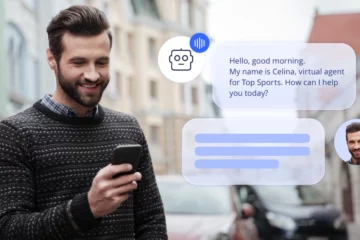The beginning of a new year always brings new resolutions, plans, and personal goals. It’s not so different for companies, which must also outline their business objectives for the next 12 months. Setting business goals is crucial for the sustainable success of a company, and undoubtedly, the strategic planning for this year should focus on the adoption of innovative technologies, with the trends of AI for 2024 being a central point.
Integrating emerging technological trends, such as Artificial Intelligence, into the 2024 strategy is not only essential for staying ahead in a competitive environment but will also enable companies to improve their efficiency, reduce costs, and obtain many more industry-specific benefits. Below, we will explore four AI trends expected to have a significant impact on businesses in 2024.
Trend 1: Advanced
Virtual Assistants
It is expected that virtual assistants, which began to gain popularity with the Conversational AI wave of 2023, will not only continue to grow in user adoption but also acquire advanced capabilities such as natural voice communication, proactive conversations, interaction with other bots, and more.
Virtual Assistants (VAs) differ from traditional chatbots, typically limited to predefined responses and lacking understanding of multiple intentions, by having the ability to comprehend intent from a single expression. They can even understand responses for which they have not been explicitly programmed, using Procesamiento del Lenguaje Natural (NLP).
Conversational bots, like those developed by inConcert, leverage Machine Learning and Deep Learning to intelligently expand the VA’s understanding of vocabulary and colloquial language, resulting in more precise and accurate responses. Additionally, they can provide customized responses based on segmentation or other given information. These intelligent virtual assistants are often tailored to specific roles or use cases, such as marketing, customer service, and sales, and integrated with CRM systems that update in real-time as the conversation unfolds.
Trend 2: AI-Augmented Workforce
The integration of Artificial Intelligence into the workplace has been crucial for optimizing processes, increasing productivity, and generating revenue during 2023. However, in 2024, we will observe more strongly how it creates new jobs and “augments” existing ones.
Workforce augmented by AI refers to the upgrading and strengthening of workers’ skills through this technology. This allows employees to handle more complex and strategic tasks, while AI takes care of repetitive and routine tasks.
This does not mean that workers are being replaced by AI; rather, they will work together to achieve greater efficiency and results. For example, AI can analyze large amounts of data in record time compared to human capacity, enabling the generation of reports in seconds. This frees up time for employees to focus on more important and higher-value tasks or on enhancing other skills such as certifications, product knowledge, or soft skills.
Furthermore, the implementation of AI in the workplace is already creating new employment opportunities in roles related to this technology, such as “AI Specialist Agents” or “AI Communication Channel Managers.”
Digital assistant bots and agents: a frictionless
hybrid ecosystem Read now
Digital assistant bots and agents:
a frictionless hybrid ecosystem
Read now
Trend 3: Multimodal AI
Traditional Artificial Intelligence models have focused so far on processing data from a single modality: only text, only image or video, etc. A multimodal AI model will allow training a tool to discover, correlate, and communicate across different types of modalities or formats of information, enabling it to have a better understanding and provide richer and more complex results.
Let’s take the example of the difference in human experience between a voice call and a video call. Having both image and audio provides us with more information about our interlocutor: we can analyze their facial expressions, and that, combined with the tone of voice, can lead us to conclude whether they are calm, happy, or focused. The same applies to a multimodal AI model, as it can integrate different modalities of information to obtain more precise and comprehensive results.
This trend is particularly relevant for customer service, as a multimodal bot can not only communicate with a person through text but also through voice if the customer wishes to switch channels, analyze their feelings, and summarize the conversation for human agents.

Trend 4:
Hyper-personalized CX by AI
Before AI, it was already possible to connect CRMs with automation tools and personalize certain communications, such as email campaigns, to some extent. With this technology, we have evolved from including customers’ real names in texts to incorporating payment due dates or membership renewal dates.
The latest among the AI trends for 2024 is the hyper-personalization of the customer experience. It means to take one step further what automation allows us to do. AI leverages all available information to create deeply personalized interactions at every touchpoint of the customer journey. This means that customers can receive recommendations, responses, and offers specifically tailored to them in real-time, based on their actual interests, behaviors, and preferences.
The AI data-driven approach of hyper-personalization puts the customer at the center of marketing, sales, and customer service strategies. By reducing the noise of irrelevant information, it increases engagement, message relevance, and the effectiveness of interactions. This enhances their experience and can lead to greater customer retention and brand loyalty.

These are just a few AI trends for 2024, but as last year demonstrated, the growth of this technology is exponential, and its evolution is constant, so we can expect significant developments in the near future.
Subscribe to our blog to stay updated on the latest industry innovations and how they can enhance your operation.
If you’re ready to implement AI in your company, don’t hesitate to contact an inConcert advisor to find the best solution tailored to your needs.



